Why ‘One Piece’ Creator Changed His Stance on a Live-Action Adaptation: “I Realized Times Had Changed”

Eiichiro Oda, One Piece creator and executive producer on Netflix’s upcoming adaptation, says that he changed his mind about whether his long-running manga could get a live-action adaption after both technology advances and seeing Shaolin Soccer.
In a rare interview with The New York Times, the Japanese artist behind the best-selling manga in history discusses how Stephen Chow’s 2001 Hong Kong sports comedy inspired the live-action take and how he ensured his upcoming series — which follows a stream of live-action manga adaptation misses — would be satisfactory to fans.
More from The Hollywood Reporter
'One Piece' Review: Netflix's Live-Action Manga Adaptation Is a Delight
Netflix Renews 'The Lincoln Lawyer' for Season 3; Neve Campbell Departing
“When I first started, I didn’t think there was any point in drawing a manga that could be remade in live-action,” Oda said. “But when I saw the movie [Chow’s] , it felt like a manga-esque world brought to life.”
It was at that point, he says, that he changed his mind — with a little help from technological advances. “I realized times had changed, and there was technology available that could make a live-action One Piece happen. So I shifted to finding the right partner to bring the manga to life.”
One Piece follows Monkey D. Luffy, a teen whose body possesses the properties of rubber after he eats a Devil Fruit. With the help of the Straw Hat Pirates, he searches the world for a treasure known as the “One Piece,” to become the next Pirate King.
It debuted in the Weekly Shōnen Jump anthology magazine in 1997 before getting its long-running anime TV adaptation in 1999. The story has also been adapted into video games and for the big screen, including the most recent One Piece Film: Red. But Netflix’s live action interpretation is the first of its kind after attempts like Ghost in the Shell, Cowboy Bebop and Death Note have been met with less than welcome reception.
For Oda, the “history of failure” raised questions for him, and as a result, he acted as a “guard dog” over the property as the streamer and its showrunners Matt Owens and Steven Maeda brought it to screen.
“Various manga had been made into live action, but there was a history of failure; no one in Japan could name a successful example. Would fans of “One Piece” — and viewers who don’t know the manga — accept it?” he told the Times. “Thankfully, Netflix agreed that they wouldn’t go out with the show until I agreed it was satisfactory. I read the scripts, gave notes and acted as a guard dog to ensure the material was being adapted in the correct way.”
In an earlier note to fans, Oda expressed that he made “no compromises” on the show, which was seven years in the making. And while he’s sure some fans will be vocal about changes made amid the show’s efforts to present “things in a way that can only be done in live action,” he calls the show’s team “pros” and One Piece “superfans.”
“Even after the shoot was over, there were numerous scenes the production agreed to reshoot because I felt they weren’t good enough to put out into the world,” he wrote. “On the other hand, there were lines that I thought didn’t feel like Luffy on paper…but when I saw the filmed scenes, I went, ‘It works when it’s Iñaki [Godoy] performing it as Luffy.'”
“There were so many things that had to be done to keep things from looking too unnatural in live-action,” he added.
Reviews are not yet out on the Netflix series, but Oda’s approach to One Piece‘s live-action is by his accounts careful, particularly in terms of how it brings what fans love about the characters to screen. It’s something he says is key to any successful live-action manga adaptation.
“A live-action adaptation of a manga doesn’t simply re-enact the source material on a one-to-one basis: It involves really thinking about what fans love about the characters, the dynamics among them — and being faithful to those elements,” he told the NYT. “A good live-action show doesn’t have to change the story too much. The most important thing is whether the actors can reproduce the characters in a way that will satisfy the people who read the manga. I think we did it well, so I hope audiences will accept it.”
Best of The Hollywood Reporter

 Yahoo News
Yahoo News 